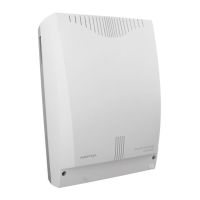Ascotel IntelliGate 2025/2045/2065
558 Features Part 2
Besides these settings the authorization to send short messages to an ESME can
be enabled or disabled for each subscriber:
"Send SMS = Yes / No" (Inizialitation settings = Yes)
A web-based configuration is loaded into the browser via the AIMS Shell for the
configuration of the ESME.
The use of the SMPP protocol to integrate an SMS server is subject to a licence
(see "Licence-related System and Expansion Limits", page 593).
8.8.2 Alarm handling
External alarms from an alarm server are not handled by the SMSC but sent
directly to the corresponding destination terminal. No more alarms can be sent to
the corresponding terminal if the storage location is full. The alarm server is
responsible for ensuring that alarms are delivered.
Other Properties and System Limits:
• Alarms take priority over messages.
• Max. length of alarm message texts is 160 characters.
• A maximum of 16 alarms can be stored for each subscriber. No more alarms
can be delivered after that.
• Alarms are always routed to the destination defined in the send command; Call
Forwarding Unconditional and Call Forwarding on No Reply operations have no
effect.
• Several alarm sources can be connected to each PBX.
Default ESME Messages without a destination address are sent to the default ESME.
Password The password is checked every time a connection is set up between
SMSC and ESME (minimum length = 4).
Response time Max. amount of time the SMSC waits for an answer from the ESME [0...5
minutes]
Parameter Remarks

